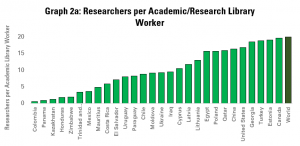In recent weeks, we have looked at how numbers of academic libraries and library workers stand around the world, and what correlations there are between these, in relation to total populations, and indicators of innovation such as publishing and patenting.
Another angle worth exploring is the relationship between numbers of academic library workers, and those who benefit most directly from their services – students in tertiary education and people working in the research sector.
We can start to explore this by looking at data from the UNESCO Institute for Statistics on numbers of people working in research, and OECD data on the number of people registered in tertiary education, combined with data from IFLA’s Library Map of the World.
In each case, there is not data available for every country. In particular, OECD data is focused on its own members, with a few additional countries, meaning that averages offered are only relative to a part of the world.

Graph 1 looks at students. Students can benefit strongly from well-supported academic libraries, in order to help them benefit from well-designed collections, find resources effectively, and develop key skills.
The data available indicates that on average, each full-time academic library worker serves 207.7 students. The smallest number of students per librarian was in Germany – 157.6, with eight countries in total coming below the global average, of which seven are European, and the other is Canada.
Among other regions for which data is available, Colombia had the smallest number of students per librarian in Latin America and the Caribbean, and Japan in Asia-Oceania. There are some very high figures for numbers of students in some countries, which may be due to under-counting.


Graphs 2a and 2b look at research personnel (to note different scales on the vertical axis). As has been underlined in previous posts, libraries are a key part of the research infrastructure for any country, not only ensuring that researchers can access knowledge and ideas from elsewhere, but also increasing helping to ensure effective dissemination and management of data.
Globally, the data indicates that there are on average 20 research workers for every worker in an academic or research library.
The smallest number of academic and research library workers per researcher was in Colombia, with 0.6. Eight countries in total have fewer than five researchers per academic and research library worker – as well as Colombia, Panama, Kazakhstan, Honduras, Zimbabwe, Trinidad and Tobago, Mexico and Mauritius.
Meanwhile, a number of countries had figures of more than 100 researchers per academic or research librarian, although this may be down to under-reporting of numbers of librarians.
Clearly the profile of academic libraries themselves varies strongly, depending on institutions themselves. Some will focus much more on educating undergraduates, others much more on supporting more advanced research work.
As a result, a low number of researchers per librarian can be an indicator as much of a large number of librarians (because of strong investment in research libraries) as of a small number of researchers (because a institutions has relatively little focus on research, and more on teaching in general).
A similar reflection can apply to numbers of students. A system more focused on research may therefore employ more research librarians, raising the ratio of library workers to students, but so too could a smaller number of students.
We will explore these issues further next week.
Find out more on the Library Map of the World, where you can download key library data in order to carry out your own analysis! See our other Library Stats of the Week! We are happy to share the data that supported this analysis on request.